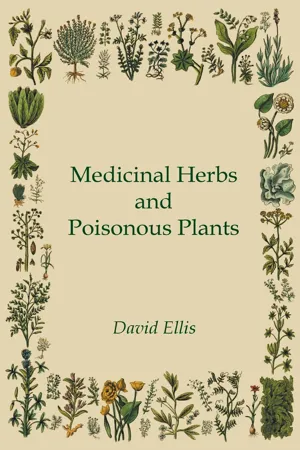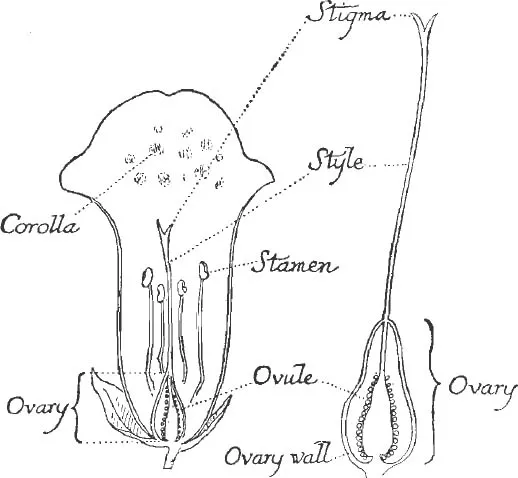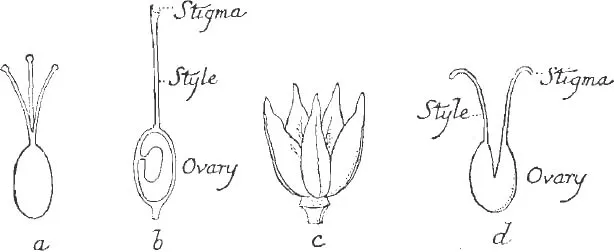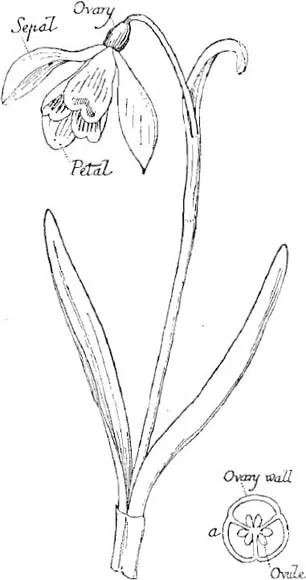![]()
MEDICINAL HERBS AND POISONOUS PLANTS
CHAPTER I
THE STRUCTURE OF THE FLOWER
Some knowledge of the structure of flowers is a necessary qualification for the study of poisonous and medicinal plants, for many plants can be identified by their flowers, and in many cases difficulties of identification can be solved by an appeal to the flower. Let us take for an example a common flower like the Buttercup and dissect it. The reader should compare a living specimen of this flower with fig. 1 and make certain that he can identify all the parts.
Each complete flower consists of four different structures arranged in whorls at the apex of a stalk. The two outermost beginning from the outside are called respectively the calyx and the corolla. The calyx consists of sepals, and the corolla of petals. Thus in the Buttercup the calyx consists of five green sepals, and the corolla of five yellow petals. Inside the corolla are the stamens; each of these is composed of a stalk which supports at its end an expanded structure called the anther. The last-named contains the pollen grains; these are liberated when ripe by the splitting of the anther, In the Buttercup the stamens are numerous. Removing the stamens, a small globular head will be left behind. This is the pistil, which in this case is not a single body, but is made up of an aggregation of similar structures. Each of these is called a carpel. We therefore speak of the pistil of the Buttercup being composed of numerous carpels.
The characters of the Buttercup may therefore be tabulated as follows:—
1. Calyx.Five green sepals.
2. Corolla.Five yellow petals.
3. Numerous stamens.
4. Pistil.Numerous carpels.
It will be further observed that the different parts of the flower are not in any way united either with themselves or with any other parts of the flower, e.g. each petal is free not only from the other petals but also from the sepals and stamens on either side of it.
We may take the Foxglove for our next example. The structure of this flower is quite different, there being considerable union among its component parts.
Examining as we did the Buttercup, we find the flower to be made up as follows:—
1. Calyx.Five united green sepals.
2. Corolla.Five united purplish petals.
3. Stamens.Four in number, attached to the petals.
4. Pistil.Two completely united carpels.
It becomes necessary at this point to explain in greater detail the difference between the pistil and the carpel. This can best be done by comparing the pistils of the two flowers which we have already described. In the case of the Buttercup (see figs. 1 and 2) each one of the little structures (fig. 2) which compose the central part of the flower is called a carpel. There are about 20 or 30 of them in each Buttercup (fig. 1). Collectively they form the pistil. Hence we say that the pistil of the Buttercup is composed of 20 or 30 carpels, just as we say that a class is composed of 20 or 30 students. Each carpel is made up of three parts:—
Fig. 1.—Section of Flower of Buttercup
Fig. 2.—Enlarged Section of Carpel
1. Stigma, or the top part, usually rough or sticky: in consequence it receives and detains the pollen grains. It often takes the shape of a small knob as in the Primrose, but this is not the case in the Buttercup.
2. Style, or the neck upon which the stigma is carried.
3. Ovary, or the lower expanded portion. This contains a cavity in which, in this case, a single ovule is developed. The ovule later develops into the seed (fig. 2).
The distinction between the terms carpel and pistil is not so easy to perceive in the case of the Foxglove flower. Here the number of carpels forming the pistil is only two, but these two are joined together (fig. 4). The evidence for the statement that the pistil is made up of two carpels is furnished by an examination of the top of the pistil, for there are seen to be two stigmas (fig. 4). Again, if the ovary be cut open, two cavities are observed. Strictly speaking, the ovary of the Foxglove is made up of two ovaries joined together; it is, in fact, a compound ouary. In the same way the style is really compound, being made up of two styles joined together. In describing the pistil of the Foxglove, we should say that it is composed of two carpels. The ovaries and styles of these two carpels are completely united in this pistil, but the two stigmas (or stigmata) are free. In other plants it will be found that the number of carpels composing the pistil is not the same, and that the degree of union of the carpels is different. In fig. 5 a few types of pistils are given, and they should be carefully studied, for the classification of the higher plants depends largely on differences in the number and mode of union of the carpels.
Fig. 3.—Section of Foxglove Flower
Fig. 4.—Enlarged Section of Pistil
Fig. 5.—Various Types of Pistils
The Snowdrop will supply us with our third example. Examining as before, we find it to be constructed as follows:—
1. Calyx.Three white sepals.
2. Corolla.Three white petals.
3. Sixstamens.
4. Pistil.Three carpels.
As is shown in fig. 6, the ovary in this flower is situated below the other parts of the flower. In this case the ovary is said to be inferior; in the flowers examined above, the ovary is said to be superior: it is enveloped by, not situated underneath, the calyx and corolla.
Fig. 6.—The Snowdrop a, Section of ovary.
The reasons for the statement that the pistil is composed of three carpels should be carefully examined by the student. The first reason is furnished by the ovary, which, if cut open, shows three cavities (fig. 6, a); the second by the stigma, which is made up of three lobes closely joined together.
There is still another feature of interest in this flower, namely the prominence of the calyx. It is popularly supposed that the most conspicuous outer parts of a flower must necessarily be the corolla. As a matter of fact, whilst this is the case in the majority of flowers, it is not safe to rely on it; the safest rule to follow is to ascribe to the calyx the outer members, and to the corolla the inner members irrespective of their appearance. In the Snowdrop, for instance, an examination will show that three of the so-called petals are placed outside of the other three; the inner three must therefore be regarded as petals, and the outer three as sepals.
Finally, we must mention the differences in the flowers brought about by differences in the shape of the receptacle. This is the name given to that part of the flower-stalk which bears the floral parts. In most flowers the receptacle is just the rounded convex end of the stalk (fig. 7, a). On such a structure the pistil rises from the summit, the other floral parts arising successively immediately below it. A flower of this kind is said to be hypogynous. In other flowers the receptacle takes the form of a cup (fig. 7, c) or a saucer (fig. 7, b). In both forms the pistil arises from the...






